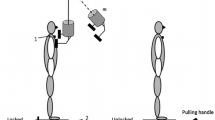Summary
The effect of the direction of unexpected horizontal perturbations of stance on the organization of automatic postural responses was studied in cats. We recorded EMG activity in eight proximal and distal muscles of the hindlimb along with vertical forces imposed by the limbs in awake behaving cats while they stood on an hydraulic platform. Postural responses to motion of the platform in 16 different horizontal directions were recorded. Vertical force changes were consistent with passive shifts of the center of mass and active correction of stance by the animals. When the perturbation was in the sagittal plane, vertical force changes began about 65 ms following initial platform movement. When the perturbation contained a component in the lateral direction, latency for vertical force changes was about 25 ms and an inflection in the vertical force trace was observed at 65 ms. No EMG responses were observed with latencies that were short enough to account for the early force component and it was concluded that this force change was due to passive shifts of the center of mass. The amplitude of the EMG responses of each muscle recorded varied systematically as perturbation direction changed. The directions for which an individual muscle showed measurable EMG activity were termed the muscle's “angular range of activation.” No angular range of activation was oriented strictly in the A-P or lateral directions. Most muscles displayed angular ranges of activation that encompassed a range of less than 180°. Onset latencies of EMG responses also varied systematically with perturbation direction. The amplitude and latency relationships between muscles, which made up the organization of postural responses, also varied systematically as perturbation direction was changed. This result suggests that direction of perturbation determines organizational makeup of postural responses, and for displacements in the horizontal plane, is considered a continuous variable by the nervous system.
Similar content being viewed by others
References
Buchanan TS, Almdale DPJ, Lewis JL, Rymer WZ (1986) Characteristics of synergic relations during isometric contraction of human elbow muscles. J Neurophysiol 56: 1225–1241
Dunbar DC, Horak FB, Macpherson JM, Rushmer DS (1986) Neural control of quadrupedal and bipedal stance: implications for the evolution of erect posture. Am J Phys Athropol 69: 93–105
Horak FB, Diener HC, Nashner LM (1985) Influence of stimulus parameters and set on human postural synergies. Soc Neurosci Abstr 15: 704
Horak FB, Nashner LM (1986) Central programming of postural movements: adaptation to altered support-surface conditions. J Neurophysiol 55: 1369–1381
Macpherson JM, Rushmer DS, Dunbar DC (1986) Postural responses in the cat to unexpected rotations of the supporting surface: evidence for a centrally generated synergic organization. Exp Brain Res 62: 152–160
McCollum G, Horak FB, Nashner LM (1985) Parsimony in neural calculations for postural movements. In: Bloedel JR, Dichgans J, Precht W (eds) Cerebellar functions. Springer, Berlin, pp 52–66
Moore SP, Horak FB, Nashner LM (1986) Influence of stimulus anticipation on human postural responses. North Am Soc Psychol Sport Phys Activity, Scottsdale Arizona (Abstracts)
Moore SP, Rushmer DS (1987) Automatic postural responses of humans to horizontal perturbations of stance in different directions. Proc North Am Soc Psychol Sports Phys Activity, Vancouver, BC
Nashner LM (1977) Fixed patterns of rapid postural responses among leg muscles during stance. Exp Brain Res 30: 13–24
Nashner LM, McCollum G (1985) The organization of human postural movements: a formal basis and experimental synthesis. Behav Brain Sci 8: 135–172
Nashner LM, Woollacott M, Tuma G (1979) Organization of rapid responses to postural and locomotor-like perturbations in standing man. Exp Brain Res 36: 463–476
Rushmer DS, Russell CJ, Macpherson JM, Phillips JO, Dunbar DC (1983) Automatic postural responses in the cat: responses to headward and tailward translation. Exp Brain Res 50: 45–61
Rushmer DS, Windus SL, Russell CJ (1986) Automatic postural responses in the hindlimb of the cat to horizontal perturbations of stance in different directions: variations in synergic organization. Abstract, Symposium on Neural Control of Limb Movement, Seattle Wash
Author information
Authors and Affiliations
Rights and permissions
About this article
Cite this article
Rushmer, D.S., Moore, S.P., Windus, S.L. et al. Automatic postural responses in the cat: responses of hindlimb muscles to horizontal perturbations of stance in multiple directions. Exp Brain Res 71, 93–102 (1988). https://doi.org/10.1007/BF00247525
Received:
Accepted:
Issue Date:
DOI: https://doi.org/10.1007/BF00247525




